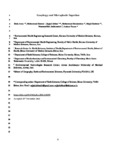Geophagy and microplastic ingestion
| dc.contributor.author | Amiri, H | |
| dc.contributor.author | Hoseini, M | |
| dc.contributor.author | Abbasi, S | |
| dc.contributor.author | Malakootian, M | |
| dc.contributor.author | Hashemi, M | |
| dc.contributor.author | Jaafarzadeh, N | |
| dc.contributor.author | Turner, Andrew | |
| dc.date.accessioned | 2022-02-08T13:42:40Z | |
| dc.date.available | 2022-02-08T13:42:40Z | |
| dc.date.issued | 2022-03 | |
| dc.identifier.issn | 0889-1575 | |
| dc.identifier.issn | 1096-0481 | |
| dc.identifier.other | 104290 | |
| dc.identifier.uri | http://hdl.handle.net/10026.1/18700 | |
| dc.description.abstract |
Microplastics (MPs) are ubiquitous and pervasive contaminants whose impacts on human health are unclear but are gaining interest in the scientific literature. Human exposure to MPs may arise through inhalation and ingestion, with research into the latter route focusing on foodstuffs and beverages contaminated from the environment or during processing and preparation. What has not been considered thus far, however, is MP exposure through geophagy, or the cultural, culinary or compulsive ingestion of contaminated soil and dirt. In this study, soils from the island of Hormoz, Iran, and spices prepared from these soils were analysed for MP contamination. Fibres of polyethylene terephthalate, nylon, polystyrene or polypropylene were detected in the soils and a composite spice derived from packaged products, with the MP concentration greatest in the latter sample (0.1 MP g−1). Although typical consumption of this material results in MP exposure that is lower than that arising from the dietary consumption of fish and bottled water, for example, geophagy more generally may represent a significant means of exposure for humans and animals that deliberately ingest geosolids. | |
| dc.format.extent | 104290-104290 | |
| dc.language | en | |
| dc.language.iso | en | |
| dc.publisher | Elsevier | |
| dc.subject | Microplastics | |
| dc.subject | Geophagy | |
| dc.subject | Ingestion | |
| dc.subject | Pollution | |
| dc.subject | Contaminated food | |
| dc.subject | Iran | |
| dc.title | Geophagy and microplastic ingestion | |
| dc.type | journal-article | |
| dc.type | Journal Article | |
| plymouth.author-url | https://www.webofscience.com/api/gateway?GWVersion=2&SrcApp=PARTNER_APP&SrcAuth=LinksAMR&KeyUT=WOS:000803854200026&DestLinkType=FullRecord&DestApp=ALL_WOS&UsrCustomerID=11bb513d99f797142bcfeffcc58ea008 | |
| plymouth.volume | 106 | |
| plymouth.publication-status | Published | |
| plymouth.journal | Journal of Food Composition and Analysis | |
| dc.identifier.doi | 10.1016/j.jfca.2021.104290 | |
| plymouth.organisational-group | /Plymouth | |
| plymouth.organisational-group | /Plymouth/Faculty of Science and Engineering | |
| plymouth.organisational-group | /Plymouth/Faculty of Science and Engineering/School of Geography, Earth and Environmental Sciences | |
| plymouth.organisational-group | /Plymouth/REF 2021 Researchers by UoA | |
| plymouth.organisational-group | /Plymouth/REF 2021 Researchers by UoA/UoA07 Earth Systems and Environmental Sciences | |
| plymouth.organisational-group | /Plymouth/Research Groups | |
| plymouth.organisational-group | /Plymouth/Research Groups/BEACh | |
| plymouth.organisational-group | /Plymouth/Research Groups/Marine Institute | |
| plymouth.organisational-group | /Plymouth/Users by role | |
| plymouth.organisational-group | /Plymouth/Users by role/Academics | |
| dcterms.dateAccepted | 2021-11-16 | |
| dc.rights.embargodate | 2023-1-11 | |
| dc.identifier.eissn | 1096-0481 | |
| dc.rights.embargoperiod | Not known | |
| rioxxterms.versionofrecord | 10.1016/j.jfca.2021.104290 | |
| rioxxterms.licenseref.uri | http://www.rioxx.net/licenses/all-rights-reserved | |
| rioxxterms.licenseref.startdate | 2022-03 | |
| rioxxterms.type | Journal Article/Review |


